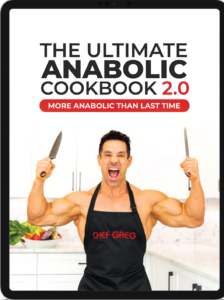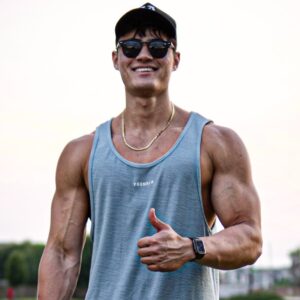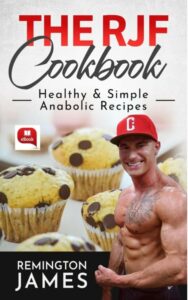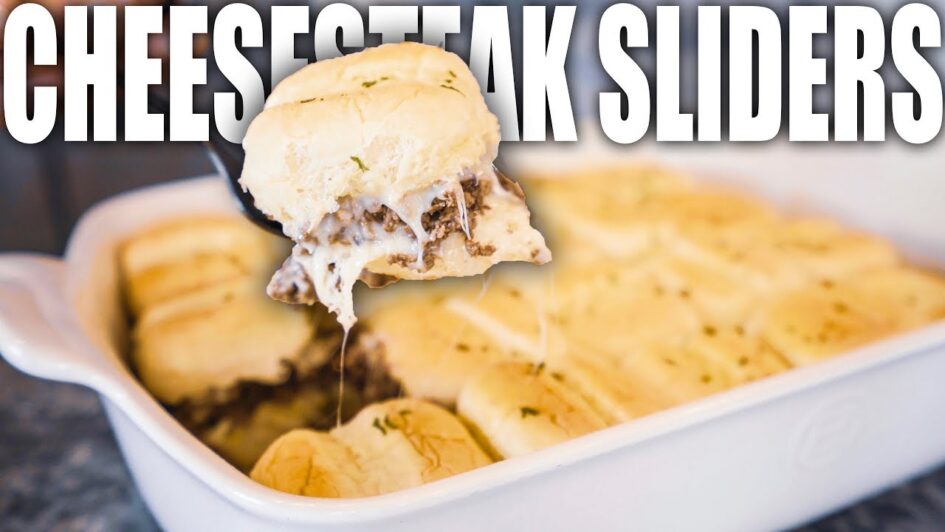I’ve dedicated the past six years of my life to weight training and dieting. It’s a passion of mine that motivates me to get out of bed every day and I look forward to the hour and a half I give myself to train in the gym. I also look forward to the meals that I make myself every day. The typical bodybuilder stereotype meal is composed of bland chicken, rice, and broccoli. Every time a celebrity or actor gains an impressive amount of muscle in a small period of time, they always credit their growth to this meal saying they ate it every day for months when that’s probably not true.
Within the past couple years, in the bodybuilding or fitness community, there have been a surge of creators and influencers who have been creating recipes of healthier alternative foods that may be considered as “junk” to the laymen. Fitness pages across social media have been making healthier versions of foods like doughnuts, pizza, burritos, brownies, etc that may seem off limits to someone on a diet. Coined by Youtuber, Greg Doucette IFBB Pro Bodybuilder and MS Kinesiology, this approach is known as the “Anabolic Diet.” and before was known as “flexible dieting.”
The theory behind this is to take these fun tasting junk foods and substitute the normal ingredients for ingredients that are lower in calories. These foods are low calorie dense – meaning there’s a large quantity of food for a small amount of calories – and also have a higher protein and fiber content. By eating these foods, you’ll be fuller for longer, you’ll be less likely to binge eat, and you will be happier through your diet since you get to enjoy foods you already enjoy. This “anabolic” alternative may not be as good as the real thing, but it may be 80-90% as good as the real thing, which is still a lot better than sticking to bland chicken and rice or having the mindset that certain foods are “off limits.”
I have been incorporating said foods within my diet these past couple of years. I’ve had a lot of fun cooking the foods and love the variety, all while staying within my caloric means. After I graduate university, I will be a personal trainer at Lifetime Athletic. I mainly will be training high school athletes, as I once was, who are looking to get bigger and stronger for their respective sport.
The idea I’m proposing for my Senior Capstone project is to compose a recipe book of the “anabolic” foods I’ve enjoyed and make on a regular basis. I plan on giving this recipe book to future clients. I want them to learn that dieting can be fun and you don’t have to sacrifice good tasting foods to get the results you want.
A lot of the recipes I make are not my own original creations, so when I compose this cookbook, I will be sure to credit the creator of the recipe. The originality in the project will come from the photography I plan to incorporate in the book, my review of each recipe, as well as the overall design of the book. I plan on taking self portraits while in a gym setting and I will also be taking portraits of the foods I make. The self portraits don’t really have anything to do with the content of the book, rather it’s a stylistic choice I want to incorporate to make the book look “cool” and appeal to my target audience. I want my clients to see that you can build an impressive physique all while having fun with food at the same time.
What form will the cookbook take and who inspired the idea?
I plan on making my cookbook in an ebook format instead of a print book. I think this is a better alternative because a digital format will appeal to and suit my target audience, which is teenagers who are either looking to gain or lose weight. As I envision this cookbook, the first thing I want to do is talk about the concept of “flexible dieting” or the “Anabolic Diet” and how it can be easy for new trainees to fall into the trope of eating bland and boring foods. I will also address some criticism about it and why I think it can still be incorporated into a diet or training program if done correctly.
Once I actually dive into the recipes, the name of the food will be at the top of the page followed by an ingredient list and set of instructions. A photo of the finished product will be to the left of the text. Finally, I will discuss my opinion about the recipe, why I like it, and why it’s worked for me. This will be the “review” aspect of the cookbook and I’ll tell the audience my honest opinion about the food. I will incorporate the self portraits later on as I start to flesh out a design persona for the book and see where the pictures fit best with the layout of it.

Greg Doucette: “The Ultimate Anabolic Cookbook 2.0: More Anabolic Than Last Time”
The cookbook I plan to create is inspired heavily by Greg Doucette and Remington James. These are two online personalities who are well respected as creators within the fitness community and both have at least half a million subscribers each, respectively. They both have created their own cookbooks with recipes similar to the ones I described. Unfortunately, though, I never purchased either of their cookbooks, so I can’t take direct inspiration from those works or provide a hyperlink to them. All the recipes I have made are available for free on Youtube and some I even found on TikTok from other creators and also enjoyed. Instead, I am inspired by the idea of their cookbooks, their methodology about dieting, and will be composing a book truly original to me in terms of design.
For the self portraiture aspect of the project, I follow a lot of fitness influencers that I will be using as mentor accounts for their photos. The main Instagram accounts that will inspire my photographs are @sooshbrah, @westongarland, and @davidlaid. These creators target a demographic similar to the one I’m going for, and I also really like the aesthetics of their photographs. I’m similar in age to all three of these creators, so I think I’d be able to pull off their look and could really gain some good inspiration from their posts.
How will my demographic benefit from the cookbook and put it to use?
As mentioned prior, I most likely will be training high schoolers and some might be athletes who are looking to get in shape for their sport. That’s mainly who I will be targeting with this cookbook. I want to show them that they can use the recipes in any way they want depending on their goals. If they’re really skinny and want to bulk up for football or wrestling, let’s say, they can increase the amount of ingredients by 30%, 50%, 100%, or however they please to reach their goals. The inverse goes for someone looking to lose weight. They can also simply follow the recipes as they’re written. There’s no “set in stone” rules here.
I’ve personally used these recipes for three instances: bulking to gain weight, cutting to lose fat, and maintaining my physique. I simply adjusted my portion sizes to fit the daily calorie goal I had in mind.
I feel that this cookbook will have a very positive impact upon my future clients, even if I do venture out into training clients who are a bit older. These recipes can be eaten by any one, at any age, for any type of goal. Right now, I’m just trying to appeal to the people I’ll be training in the near future. The “anabolic diet” aims to destigmatize dieting and show that no food is totally off limits. It simply takes a bit more creativity to swap out higher calorie ingredients for lower calorie ones. Additionally, that’s not to say that you can never eat a Dunkin Donut again and always have to eat the anabolic version. You can have the Dunkin Donut every once in a while too. Just as long as the good eating decisions outweigh the bad eating decisions, that’s all that really matters.
What experience do I have that will allow me to pursue the principles discussed?
Last semester, I took Digital Photography I as a Communication Option course. It’s an adjunct course, meaning it’s not directly related to my major, but is similar in terms of subject matter and form. The class shot photos weekly with either a Nikon or Canon camera – sometimes with a tripod – that we borrowed from the Art Department. We then edited those photos using Adobe Lightroom and some students took the photos to Adobe Photoshop if there was some sort of special effect they wanted to give the photo.

Pictured: @sooshbrah on Instagram
I used Photoshop in my Design Aesthetics course, which is a major course closely related to graphic design. I really didn’t feel comfortable with my Photoshop capabilities in that class, and so for this project, I’m going to be using the website Canva to design the cookbook as an alternative. I’ve used Canva many times in the past, it’s very user friendly, and I feel comfortable with that software. I also feel pretty comfortable with my ability to manually operate a camera and to further edit those photos in Lightroom.
This project will still present a challenge for me as I will have to create a design persona that is unique to me and I will be pushing my boundaries from a photography aspect as well. When in Digital Photography, I flourished in the self portrait unit, and once I learned this skill, I tried to incorporate self portraiture into my projects whenever I could. I plan to push the boundaries a bit as doing self portraiture while in a gym setting will be a new experience for me. I also will be pursuing food photography as well, which is something I dabbled in while in photography class, but I hardly ever submitted those photos for a grade. This project will challenge me to perfect that part of my photography skills and also expand upon the knack I already have for self portraits.

Remington James: “The RJF Cookbook: Healthy & Simple Anabolic Recipes”
Here is a Dropbox link to my Digital Photography catalog. The content includes, but is not limited to, self portraiture.
What research will be necessary to create the cookbook?
I plan on using the mentor accounts mentioned prior to influence my work and I’ll be examining their photographs or their nutrition methodologies in the creation of my project. It’s possible that I may have to learn some new camera functions, but it’s too early for me to say at this point. Gyms have all different types of lighting. This is an important aspect in both photography and bodybuilding, so that’s something I have to be wary of as I go to take my photographs in the gym. I also can look at other pages that are dedicated to food photography and gain inspiration from those photos.
What are some of the obstacles I will face?
The biggest obstacle I’ll be facing is the ethics and logistics of gaining permission to take photographs in the gym. The gym I currently attended – also employed – is Lifetime Athletic, which is a commercial gym. Most commercial gyms have policies against photography or videography for privacy and safety reasons for the other members of the club. Full disclosure, I tried it once for photography class and was shut down immediately.
In an effort to not ruffle any feathers at my own training facility and workplace, I won’t even attempt to ask for permission to take photographs at Lifetime. Instead, I have two private gym options I have in mind to take my photographs. The first gym is Bamn Fitness in Fishtown (neighborhood in Philadelphia). My own personal trainer trains clients there independently. If that falls through, my second option is to buy a membership at PWRBLD Gym in King of Prussia. Before joining, I’ll have to inform the manager of my intentions explicitly and ask for permission. I’ll have a much better shot at taking the photos in a private gym versus a commercial gym.
Additionally, I will need to borrow a camera and a tripod from either the Communications Department or the Art Department so that I can take the self portraits and the food portraits.
How long is this going to take?
The timeline below is tentative. My goal is to cook two recipes per week and create a page for each, but this is subject to change if there are time constraints.
Either way, I plan on having 10-20 recipes within the book. Once I find a gym that will allow me to take photos, I’ll be doing it continuously week by week and adding in the edited photos where I think fit best in terms of design.
Week 5: rent out Sony mirrorless camera from the gear room. Prep work should include researching photography techniques, how to use the camera, and taking sample photos.
Week 6: Work on bio and pre write all the recipes & review of each recipe that will be used in the book.
Week 7: Work on cover art and design persona
Week 8: Cook recipes 1-3. Take 10-20+ photos of the finished product. Edit the photos in Lightroom. Create a page for the recipe in the recipe book.
Week 9: Cook recipes 4-6. Take 10-20+ photos of the finished product. Edit the photos in Lightroom. Create a page for the recipe in the recipe book.
Week 10: Cook recipes 7-9. Take 10-20+ photos of the finished product. Edit the photos in Lightroom. Create a page for the recipe in the recipe book.
Week 11: Cook recipes 10-12. Take 10-20+ photos of the finished product. Edit the photos in Lightroom. Create a page for the recipe in the recipe book.
Week 12: Cook recipes 13-15. Take 10-20+ photos of the finished product. Edit the photos in Lightroom. Create a page for the recipe in the recipe book.
Week 13: Cook recipes 16-18. Take 10-20+ photos of the finished product. Edit the photos in Lightroom. Create a page for the recipe in the recipe book.
Week 14: Create 5 “bite sized” Instagram Posts and a postcard for the cookbook
Week 15 & 16: work on final presentation
Finally
I’m aware this proposal is very long and drawn out. I feel as though I needed to take time and explain my ideas thoroughly because bodybuilding/fitness is a very niche interest with a lot of jargon and complex concepts. If I assumed the audience knew everything I knew, then this proposal wouldn’t have made any sense. I appreciate your patience through the explanation of this project. I aim to create a product that encapsulates what I learned as a Communications major while also making a positive impact on the world.

Leave a Reply